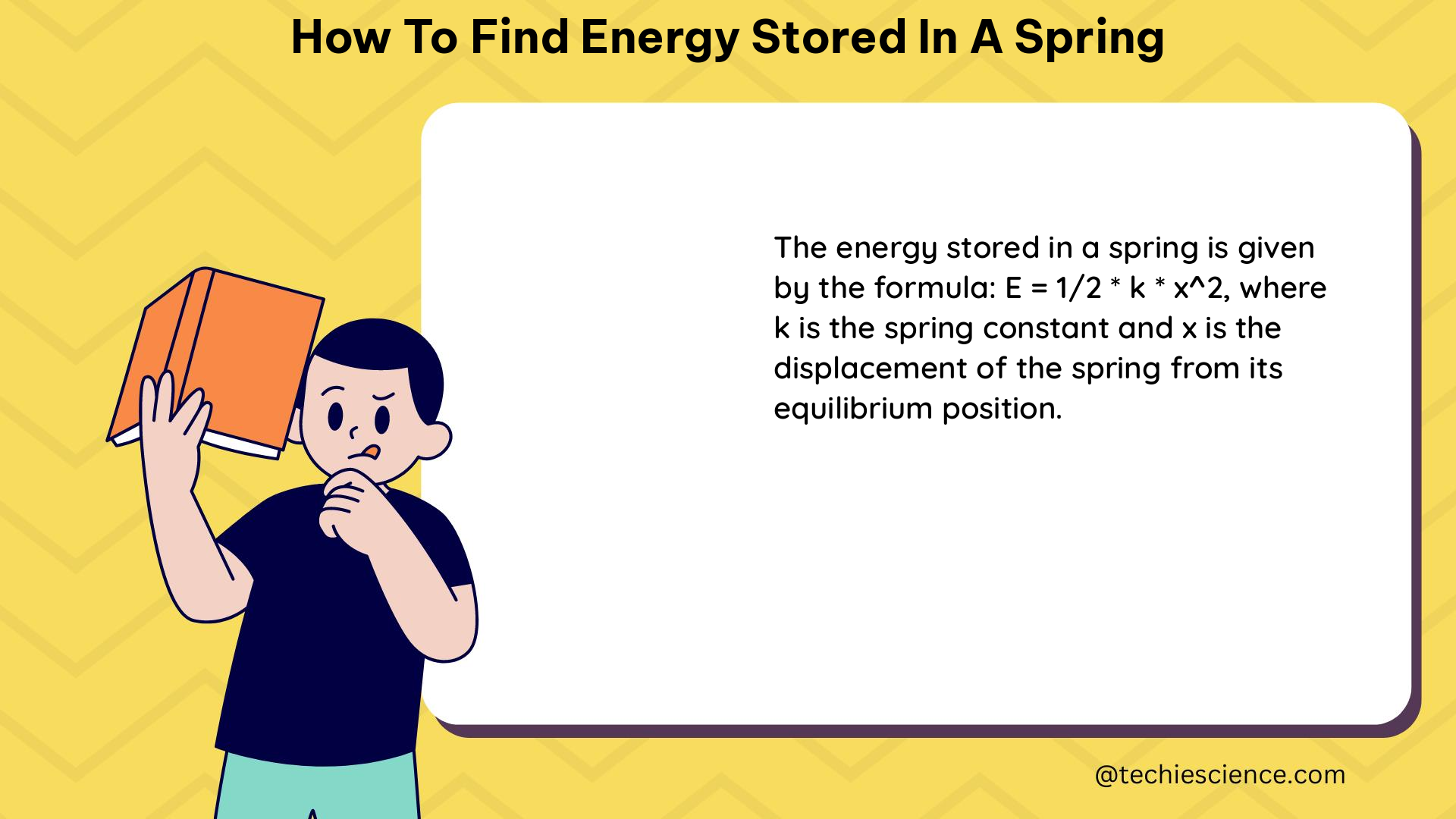The energy stored in a spring is a form of potential energy, which is the energy an object possesses due to its position or configuration. This energy can be harnessed and utilized in various applications, from simple mechanical devices to complex engineering systems. In this comprehensive guide, we will delve into the intricacies of calculating the energy stored in a spring, providing you with a thorough understanding of the underlying principles and practical applications.
Understanding Hooke’s Law and Elastic Potential Energy
The foundation for understanding the energy stored in a spring lies in Hooke’s Law, which states that the force required to stretch or compress a spring is proportional to the distance it is stretched or compressed. Mathematically, this relationship can be expressed as:
F = -k × x
where:
– F is the force applied to the spring
– k is the spring constant, which measures the stiffness of the spring
– x is the displacement or extension of the spring from its equilibrium position
By integrating the force over the distance, we can derive the formula for the elastic potential energy (EPE) stored in the spring:
EPE = 0.5 × k × x^2
This formula tells us that the energy stored in a spring is directly proportional to the square of the extension and the spring constant.
Determining the Spring Constant

To use the formula for elastic potential energy, we need to know the spring constant k. The spring constant can be determined through various methods, including:
- Static Measurement: Attach known masses to the spring and measure the resulting extension. The spring constant can then be calculated using the formula:
k = F / x
where F is the force (weight of the mass) and x is the extension.
- Dynamic Measurement: Attach the spring to a mass and observe the oscillation frequency. The spring constant can be calculated using the formula:
k = (4π^2 × m) / T^2
where m is the mass and T is the period of oscillation.
- Manufacturer Specifications: Many springs come with the spring constant specified by the manufacturer, which can be used directly in the energy calculation.
Regardless of the method used, it is important to ensure that the spring is operating within its linear range, where Hooke’s Law applies.
Calculating the Energy Stored in a Spring
Once we have the spring constant k and the extension x, we can use the formula for elastic potential energy to calculate the energy stored in the spring:
EPE = 0.5 × k × x^2
For example, if we have a spring with a spring constant of 80 N/m that is extended by 1.5 m, the energy stored in the spring would be:
EPE = 0.5 × 80 N/m × (1.5 m)^2
EPE = 90 J
This means that the spring can store 90 joules of potential energy when it is extended by 1.5 meters.
Practical Applications and Considerations
The energy stored in a spring has numerous practical applications, including:
-
Shock Absorption: Springs are commonly used in suspension systems, such as those found in vehicles and machinery, to absorb and dissipate energy during impacts and vibrations.
-
Energy Storage: Springs can be used to store energy, which can then be released to perform useful work, such as in the case of mechanical clocks and watches.
-
Kinetic Energy Conversion: When a spring is released, the stored potential energy is converted into kinetic energy, which can be used to power various devices, such as catapults and toy cars.
When working with springs, it is important to consider the following factors:
- Spring Material: The material of the spring, such as steel or titanium, can affect its stiffness and energy storage capacity.
- Spring Geometry: The shape and dimensions of the spring, such as its coil diameter and wire diameter, can also influence its performance.
- Stress and Strain Limits: Springs should be operated within their safe stress and strain limits to avoid permanent deformation or failure.
- Temperature Effects: The spring constant and energy storage capacity can be affected by changes in temperature, which should be taken into account in certain applications.
Conclusion
Understanding the energy stored in a spring is a fundamental concept in physics and engineering. By mastering the principles of Hooke’s Law and the formula for elastic potential energy, you can accurately calculate the energy stored in a spring and apply this knowledge to a wide range of practical applications. This comprehensive guide has provided you with the necessary tools and insights to become proficient in this topic, empowering you to tackle complex problems and design innovative solutions.
References
- Potential energy stored in a spring (video) – Khan Academy
- Energy stored in a spring Notes | Quizlet
- Question Video: Calculating the Energy Stored in a Spring … – Nagwa
- Hooke’s Law and Elastic Potential Energy – Physics Classroom
- Spring Constant Measurement Techniques – Engineering LibreTexts
- Energy Storage in Springs – Hyperphysics

The lambdageeks.com Core SME Team is a group of experienced subject matter experts from diverse scientific and technical fields including Physics, Chemistry, Technology,Electronics & Electrical Engineering, Automotive, Mechanical Engineering. Our team collaborates to create high-quality, well-researched articles on a wide range of science and technology topics for the lambdageeks.com website.
All Our Senior SME are having more than 7 Years of experience in the respective fields . They are either Working Industry Professionals or assocaited With different Universities. Refer Our Authors Page to get to know About our Core SMEs.